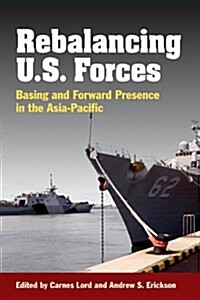
Rebalancing U.S. forces: basing and forward presence in the Asia-Pacific
- 발행사항
- Annapolis, Marylan: Naval Institute Press, 2014
- 형태사항
- xii, 226 p. : maps; 24cm
- ISBN
- 9781612514659
- 청구기호
- 349.42 L867r
- 서지주기
- Includes bibliographical references and index
- 내용주기
- Guam and American security in the Pacific / Andrew S. Erickson and Justin Mikolay -- Japanese bases and Chinese missiles / Toshi Yoshihara -- South Korea: an alliance in transition / Terence Roehrig -- The U.S. strategic relationship with Australia / Jack McCaffrie and Chris Rahman -- Singapore: forward operating site / Chris Rahman -- Diego Garcia and American security in the Indian Ocean / Walter C. Ladwig III, Andrew S. Erickson, and Justin D. Mikolay -- U.S. bases and domestic politics in Central Asia / Alexander Cooley -- The role of sea basing / Sam J. Tangredi -- About the contributors -- Index
소장정보
| 위치 | 등록번호 | 청구기호 / 출력 | 상태 | 반납예정일 |
|---|---|---|---|---|
이용 가능 (1) | ||||
| 1자료실 | 00014987 | 대출가능 | - | |
- 등록번호
- 00014987
- 상태/반납예정일
- 대출가능
- -
- 위치/청구기호(출력)
- 1자료실
책 소개
As the U.S. military presence in the Middle East winds down, Asia and the Pacific are receiving increased attention from the American national security community. The Obama administration has announced a “rebalancing” of the U.S. military posture in the region, in reaction primarily to the startling improvement in Chinese air and naval capabilities over the last decade or so. This timely study sets out to assess the implications of this shift for the long-established U.S. military presence in Asia and the Pacific. This presence is anchored in a complex basing infrastructure that scholars—and Americans generally—too often take for granted. In remedying this state of affairs, this volume offers a detailed survey and analysis of this infrastructure, its history, the political complications it has frequently given rise to, and its recent and likely future evolution.
American seapower requires a robust constellation of bases to support global power projection. Given the rise of China and the emergence of the Asia-Pacific as the centre of global economic growth and strategic contention, nowhere is American basing access more important than in this region. Yet manifold political and military challenges, stemming not least of which from rapidly-improving Chinese long-range precision strike capabilities, complicate the future of American access and security here. This book addresses what will be needed to maintain the fundaments of U.S. seapower and force projection in the Asia-Pacific, and where the key trend lines are headed in that regard.
This book demonstrates that U.S. Asia-Pacific basing and access is increasingly vital, yet increasingly vulnerable. It demands far more attention than the limited coverage it has received to date, and cannot be taken for granted. More must be done to preserve capabilities and access upon which American and allied security and prosperity depend.
Reviews
Rebalancing U.S. Forces: Basing and Forward Presence in the Asia-Pacific is an essential introduction to U.S. basing in the Pacific for defense and intelligence analysts, military planners, and strategists, and is recommended reading for students of security studies." - The Strategy Bridge "Rebalancing U.S. Forces highlights basing as an essential element of defence strategy. The essays focus primarily on naval and air forces, but also highlight the importance of controlling (or having access to) territory to project power outward from land into the sea, air and space. As the British naval strategist Sir William Corbett observed in the early twentieth century, naval and land forces must be employed in complementary ways. Today, as in the past, bases on land remain essential for deterring adversaries, reassuring allies and preserving joint-force options in times of crisis. Bases are also critical because they enable air and naval forces to control lines of communication. And control of lines of communication is important, in part, because it is necessary for the projection of joint military power onto land." --Survival:Global Politics and Strategy "Rebalancing U.S. Forces is a very informative anthology providing context of where the United States bases forces currently. The authors make a good case for continued and expanded basing in the region to support our friends, partners, and allies. They leave the reader to ponder tradeoffs that make this region logistically difficult. This is a book for planners, analysts, and State Department or congressional staffers concerned with the region. They should spend time reading Rebalancing U.S. Forces prior to making decisions about our future in the region."-- Strategic Studies Quarterly "This is an excellent book and necessary reading for anyone interested (professionally or otherwise) in security in the Asia-Pacific and or the evolving US global force posture. Individual chapters…would be recommended reading for those concerned with the respective regions. The text is written to academic standards and each chapter includes detailed endnotes: a most valuable resource for further research, in particular with regard to the Chinese sources cited. The standard of presentation and quality of editing is high. The intended audience for this book would principally be those in the academic, think tank and policy analysis communities, and…is essential reading: however, the text is also accessible to those reading for pleasure. All in all, this is an engaging book and one that is highly recommended."--The Naval Review "Lord and Erickson's essay collection will be a must-read for the entire Asian security establishment."--The Interpreter (Lowy Institute) "Unlike many anthologies, the contributions to Rebalancing U.S. Forces are uniformly excellent. Each chapter essay is thoroughly researched and sourced, and is written by experts well familiar with the history, dilemmas, and future challenges of each location. Seven first-rate maps of U.S. facilities spanning the region further enhance the book."What is the future of America's Asia-Pacific bases? Policy makers will have to continue investing in them, if only for the symbolic commitment they represent to U.S. allies. Meanwhile, these policymakers would be wise to develop operating concepts, forces, and plans that reduce reliance on these bases in the case of actual conflict. But first, they should read Rebalancing U.S. Forces to obtain a deeper understanding of the challenges America and its partners face."--The National Interest "Overall, this is a truly excellent book, and the quality and strength of each individual chapter is a reflection of the depth of knowledge of the authors assembled for the task. Its level of detail (including seven excellent maps) will also make it a useful reference text to be returned to more than once. A testimony to the book's quality is that its biggest problem is that you are left wanting more."--Proceedings "Maritime power depends on many things, Mahan taught, not least of which is an array of well-positioned, amply supplied, and strongly defended bases. The United States can no longer take for granted its ability to operate unhindered in the Asia-Pacific, which makes this volume of thoughtful essays all the more timely and important. If the shift in American power and interest to Asia is to mean anything, decision makers will have to heed the arguments advanced here." --Eliot A Cohen, Robert E. Osgood Professor of Strategic Studies, Johns Hopkins University's SAIS, and author of Supreme Command "World order in the twenty-first century will depend more and more upon the terms of the political and strategic relations between the United States and the People's Republic of China. In this very timely book, Lord and Erickson and their authors examine expertly the likelihood of achievement of an effective U.S. pivot to Asia. This is, and needs to be, largely a maritime shift in U.S. posture. A seismic correction in U.S. geostrategy is happening." --Colin S. Gray, professor of strategic studies, University of Reading, UK, and author of The Strategy Bridge and Strategy and Defence Planning "In Rebalancing U.S. Forces, Carnes Lord and Andrew Erikson have drawn together the powerful writing of the very best thinkers concerning the Pacific, U.S. forces in the region, and the atmospheric debates about the levels, location, and employment of military force in this most nautical part of the globe. This is a book that must be on the shelf of any twenty-first-century geopolitical analyst." --Adm. James Stavridis, USN (Ret.), dean, The Fletcher School of Law and Diplomacy, Tufts University, Supreme Allied Commander at NATO, 2009‒2013, and co-author of Command at Sea, 6th Edition "Rebalancing U.S. Forces provides a detailed introduction to the complex, often contentious questions surrounding the deployment of U.S. forces in Asia and the Pacific. As the United States pursues an increasingly differentiated basing strategy across the region, a deeper understanding of the history of this issue is much needed, and this volume helps point the way." --Jonathan D. Pollack, senior fellow, China and East Asian Strategy, The Brookings Institution
About the Author
Carnes Lord, currently Professor of Strategic Leadership at the Naval War College and director of the Naval War College Press, is a political scientist with broad interests in international and strategic studies, national security organisation and management, and political philosophy. He has taught at the University of Virginia, USA and the Fletcher School, and served in a variety of senior positions in the U.S. government.Andrew S. Erickson is an Associate Professor at the Naval War College and an Associate in Research at Harvard’s Fairbank Center. In spring 2013, he deployed as a Regional Security Education Program scholar aboard the USS Nimitz Carrier Strike Group.

